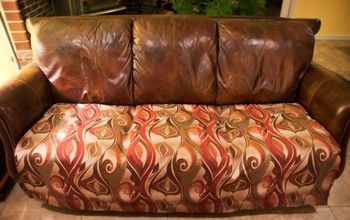How to Clean a Couch and Remove Stubborn Stains

The couch gets a lot of love. It’s where you sit back, relax, and indulge in a book, a TV show, or even a nap. It’s where the whole family (often even pets!) gathers to cuddle and connect. It’s where guests plop down to enjoy catching up with you.
But with all that attention, the couch takes a hit, with crumbs settling in the cracks, and lots of hair, body oil, and various dirt particles attaching to cushions, discoloring upholstery, creating odors, and more.
A couch is an expensive piece of furniture, so staying on top of cleanings is pertinent. Here’s everything you need to know about how to clean a couch.
Upholstery Cleaning Codes
Before you get to cleaning, check the tags on your couch for the cleaning codes, which will indicate what types of cleaners you can use on the fabric. Most upholstery pieces are labeled with one of the following cleaning codes:
– W –
Water-Based Cleaner
This code means that you can use a water-based shampoo or foam upholstery cleaner to spot clean the fabric.
– S –
Solvent Cleaner
This code means you can spot clean using a mild water-free solvent or dry cleaning product.
– WS –
Water/Solvent Cleaner
If you see this code on your couch’s tag, it means you can spot clean with a mild solvent, an upholstery shampoo, or the foam from a mild detergent.
– X –
Vacuum Only
This symbol advises you only clean the fabric by vacuuming or light brushing.
– D –
Dry Clean Only
If you see this note on your tag, do not try any of the above cleaning options, but instead take it to the dry cleaner.
Most upholstery cleaners have upholstery cleaning codes listed on the product, saving you the time from rummaging through the ingredient list. Once you understand the codes, plan to pre-test on a small area of the fabric—preferably in an inconspicuous location. That way, you will know that the cleaner and method you’re using works.
How to Remove Stains from a Couch
As soon as an accident happens, clean it up immediately. The longer you wait, the more time the stain has to set, making it more difficult to get out. Remember to identify your couch’s cleaning codes first and foremost before you get started on one of these methods to clean common stains from your couch.
How to Remove Liquid Stains on a Fabric Couch
Whether you spill your cup of coffee or a splash of red wine makes its way over the rim of your glass, here’s how to clean up liquid stains from fabric couches. In this method, you have a few options when it comes to the absorbent matter to soak up the stains and the acidic liquid solution to help lift them.
Tools and Materials Needed
- A few microfiber cloths
- Salt, baby powder, or baking soda
- Club soda, hydrogen peroxide, liquid dish soap, or diluted vinegar
- Sponge
Step 1: Blot the Stain
Blot the stained area with a microfiber cloth to remove as much of the liquid as possible. Keep blotting until the cloth comes back clean.
Step 2: Apply Absorption Product
Sprinkle salt, baby powder, or baking soda on the entire surface area of the stain to absorb the rest of the liquid. Blot again with a cloth.
Step 3: Apply Lifting Liquid
Apply club soda on a cloth and dab into the stain to wet it. Let it sit for 15 minutes and then sponge it off with water. You can also use diluted vinegar, liquid dish soap, or hydrogen peroxide in the same manner.
How to Remove Water Stains on a Leather Couch
If you happen to spill water on leather, it’s important to wipe off the water drops as soon as possible to prevent water stains from forming. But if you aren’t lucky enough to catch the water in time, it may leave a dark or chalky mark on your piece of furniture. Here’s how to remove water stains from leather; it’s important to use distilled water here, since tap water may contain chlorine, which can damage leather and might be the reason why there’s a water stain there in the first place.
Tools and Materials Needed
- Microfiber cloth
- Distilled water
- Leather conditioner
Step 1: Wipe Stain with Damp Cloth
Dampen a microfiber cloth with distilled water, then gently wipe the stain, working in circular motions.
Step 2: Let Area Dry, then Repeat Process
Let the area completely dry before checking to see if the water mark has disappeared. If still visible, repeat the process until the area is dry and the stain is noticeably gone.
Step 3: Apply a Leather Conditioner
Once the cleaned area is completely dry, apply a leather conditioner to keep the leather soft and to prevent cracks.
How to Remove Ink Stains on a Leather or Fabric Couch
A pen may be a small utensil, but it can leave a mighty stain on your couch if you’re not careful. Whether you’re trying to remove ink stains from a fabric or leather couch, we’ve got a solution for you that just requires a little soap, some rubbing alcohol, and a few other materials.
Tools and Materials Needed
- Tissues
- Washcloth
- Mild liquid dish soap
- Cotton balls
- Rubbing alcohol
Step 1: Blot the Ink Stain
Blot the ink stain immediately with a tissue, working from the outside of the stain inward to avoid spreading the ink.
Step 2: Scrub the Stain With a Damp, Soapy Cloth
Add a few drops of mild dish soap to a portion of the damp cloth. Use the soapy portion to gently scrub the stain, working from the outer edges inward. Then, use a non-soapy portion of the damp cloth to remove the soapy residue. Continue the process until all the ink is gone, and no ink transfers to the cloth.
Step 3: Apply Rubbing Alcohol
Apply rubbing alcohol to a cotton ball, then rub it on the remaining ink stain in a circular motion. Use the damp cloth to remove any leftover rubbing alcohol residue.
How to Deep Clean a Fabric Couch
A fabric sofa is prone to dirt and human and pet hair clinging to its fibers. While you should plan to vacuum your couch weekly as part of your cleaning routine and tackle spills on the spot, you may want to deep clean it a few times a year. Here’s how to properly deep clean a fabric couch.
Tools and Materials Needed
- Vacuum cleaner with an upholstery attachment
- Microfiber cloths
- Bucket
- Distilled water
- Liquid dish soap
- Distilled white vinegar
- Fan
Step 1: Vacuum the Couch
The experts at Merry Maids suggest vacuuming the fabric first and foremost, so you’re not rubbing in dirt while cleaning with the wet solution. Use the upholstery attachment for best results.
Step 2: Create Cleaning Solution
Mix about two cups of distilled water with one tablespoon of dishwashing liquid and one tablespoon of vinegar in a bucket. This will be the cleaning solution you use to clean the couch.
Step 3: Apply Solution to Couch
Dampen a microfiber cloth into the cleaning solution, then very gently rub the microfiber in circular motions over the upholstery. Be careful not to scrub hard, which can damage the fibers.
Step 4: Clean Away Solution
Clean away the solution using a fresh microfiber cloth moistened with distilled water, blotting up the solution.
Step 5: Dry
Blot again with a dry microfiber cloth. Stick a floor fan in front of the couch to help it dry faster.
Don’t Want to Wet Your Couch?
How to Deep Clean a Leather Couch
Deep cleaning your leather couch will not only keep it free of dirt and oils, but it’ll help keep the leather material healthy and less prone to cracking. Keep your leather couch in great condition by adding this cleaning method to your deep cleaning routine.
Tools and Materials Needed
- Clean microfiber towel
- Dish soap
- Warm water
- Leather conditioner
Step 1: Wipe Down the Couch
Add a few drops of mild dish soap to a damp towel, then wipe down all leather surfaces of the couch.
Step 2: Dry the Couch
Once you wipe down the couch, use a dry cloth to remove any excess water or soap.
Step 3: Condition the Leather
Apply a leather conditioner to all leather surfaces of the couch, following any specific instructions on the conditioner you use.
How to Clean a Suede Couch
As beautiful and soft as suede is, it’s one of the hardest upholstery fabrics to clean because of its silky nap, or raised surface. Not to be confused with microfiber suede couch, which is made of polyester and nylon fibers, natural suede is animal leather that has a napped or fuzzy finish. Here’s how to clean it and keep its fibers safe and smooth.
Tools and Materials Needed
- Suede brush
- Vacuum
- Suede eraser
Step 1: Vacuum and Brush the Couch
Collect debris from the couch using a vacuum. “Vacuum in a crisscross pattern to free anything that has been trapped in the folds and nap of the fabric,” suggest the experts at ServiceMaster Clean. You may also want to brush the couch using a suede brush or soft terry cloth to revive the suede’s nap.
Step 2: Remove Old Stains
For any dried-on stains, use a suede eraser to gently rub them away. If that doesn’t work, try using a soft nail file to lift away the stain, then brush the couch again to smooth the fibers back into their proper place.
How to Clean Couch Cushions
We’ve taught you how to clean the surface of your couch, but what about dirt and grime inside the actual cushions? Unless cushions in your couch are machine washable (check your couch’s tags for this info), you’ll have to put in a little work to clean them. Loosen the dirt by beating the cushions outdoors and laying them outside on a sunny day—the sun’s UV rays will work to disinfect the fabric.
Flip Cushions
How to Disinfect a Used Couch
If you buy a used couch from a thrift store or receive one from a friend or family member, it’s important you disinfect the couch to avoid bringing unwanted germs, smells, allergens, and pests—like dreaded bed bugs—into your home. Plan to deep clean the couch based on the fabric as described above for the individual couch materials. Vacuuming is the first step to sucking up loose allergens and dirt, while ingredients like vinegar, baking soda, and rubbing alcohol all work as disinfectants to remove germs.
What material is your couch made of? Share your tips for cleaning it below or check out these sofa cleaning hacks.































Frequently asked questions
Have a question about this project?